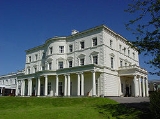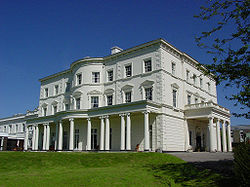
Southwick House
Encyclopedia

Southwick, Hampshire
Southwick is a village in the English county of Hampshire, situated north of Portsmouth, and is occupied entirely by tenants in the style of the Middle Ages, where the entirety is wholly owned by the Southwick Estate. Oddly, there is one exception to this and that is Church Lodge which is in...
Estate located just to the north of Portsmouth
Portsmouth
Portsmouth is the second largest city in the ceremonial county of Hampshire on the south coast of England. Portsmouth is notable for being the United Kingdom's only island city; it is located mainly on Portsea Island...
in Hampshire
Hampshire
Hampshire is a county on the southern coast of England in the United Kingdom. The county town of Hampshire is Winchester, a historic cathedral city that was once the capital of England. Hampshire is notable for housing the original birthplaces of the Royal Navy, British Army, and Royal Air Force...
, England
England
England is a country that is part of the United Kingdom. It shares land borders with Scotland to the north and Wales to the west; the Irish Sea is to the north west, the Celtic Sea to the south west, with the North Sea to the east and the English Channel to the south separating it from continental...
. The house was built in 1800 in the late Georgian style
Georgian architecture
Georgian architecture is the name given in most English-speaking countries to the set of architectural styles current between 1720 and 1840. It is eponymous for the first four British monarchs of the House of Hanover—George I of Great Britain, George II of Great Britain, George III of the United...
, to replace Southwick Park house. The house is distinct for its two-story foyer lit from a cupola, and a series of elliptical rooms. A hemi-circular portico is centered on the house's colonnade
Colonnade
In classical architecture, a colonnade denotes a long sequence of columns joined by their entablature, often free-standing, or part of a building....
of paired Ionic columns
Ionic order
The Ionic order forms one of the three orders or organizational systems of classical architecture, the other two canonic orders being the Doric and the Corinthian...
.
The house became important during World War II
World War II
World War II, or the Second World War , was a global conflict lasting from 1939 to 1945, involving most of the world's nations—including all of the great powers—eventually forming two opposing military alliances: the Allies and the Axis...
. In 1940 the estate owners allowed the Royal Navy
Royal Navy
The Royal Navy is the naval warfare service branch of the British Armed Forces. Founded in the 16th century, it is the oldest service branch and is known as the Senior Service...
(RN) to use the house to accommodate overnight pupils of the RN School of Navigation, HMS Dryad
HMS Dryad (establishment)
HMS Dryad was a stone frigate . It was the home of the Royal Navy's Maritime Warfare School until 2004.Originally the school was based in Portsmouth Dockyard. The establishment took its name from the ship used as its tender, the fourth HMS Dryad. During World War II it was moved to Southwick House...
in Portsmouth Naval Dockyard
HMNB Portsmouth
Her Majesty's Naval Base Portsmouth is one of three operating bases in the United Kingdom for the British Royal Navy...
. In 1941, after heavy bombing of the dockyard, the house was requisitioned and became the new home of HMS Dryad.
In 1943, with the planning for D-Day already underway, the house was chosen to be the location of the Advance Command Post of the Supreme Headquarters Allied Expeditionary Force
Supreme Headquarters Allied Expeditionary Force
Supreme Headquarters Allied Expeditionary Force , was the headquarters of the Commander of Allied forces in north west Europe, from late 1943 until the end of World War II. U.S. General Dwight D. Eisenhower was in command of SHAEF throughout its existence...
. Because of this, HMS Dryad was moved out of the house onto further land requisitioned from the estate.
In 1944, in the months leading up to D-Day, the house became the headquarters of the main allied commanders, including Naval Commander-in-Chief Admiral Ramsay
Bertram Ramsay
Admiral Sir Bertram Home Ramsay KCB, KBE, MVO was a British admiral during World War II. He was an important contributor in the field of amphibious warfare.-Early life:...
, Allied Supreme Commander General Eisenhower
Dwight D. Eisenhower
Dwight David "Ike" Eisenhower was the 34th President of the United States, from 1953 until 1961. He was a five-star general in the United States Army...
and the Army Commander-in-Chief General Montgomery.
After the end of the war HMS Dryad remained on site, with the house becoming the wardroom. In 2004 the functions of HMS Dryad were transferred to HMS Collingwood
HMS Collingwood (establishment)
For ships of the same name see HMS Collingwood.HMS Collingwood is a stone frigate of the Royal Navy. It is the lead establishment of the Maritime Warfare School and the largest naval training organisation in Western Europe...
in Fareham
Fareham
The market town of Fareham lies in the south east of Hampshire, England, between the cities of Southampton and Portsmouth, roughly in the centre of the South Hampshire conurbation.It gives its name to the borough comprising the town and the surrounding area...
and the site reverted to its original name of Southwick Park. Since then it has been home to the tri-Service Defence College of Policing and Guarding.
The large wall maps that were used in planning D-Day are still in place in the house, with the various markers showing the positions of the involved forces at the moment the first landing commenced.
The house is adjacent to the Royal Military Police
Royal Military Police
The Royal Military Police is the corps of the British Army responsible for the policing of service personnel, and for providing a military police presence both in the UK, and whilst service personnel are deployed overseas on operations and exercises.Members of the RMP are generally known as...
Museum. Visits are by appointment only.

